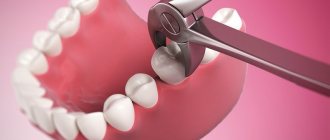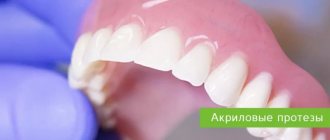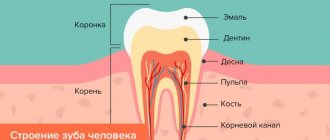Tooth extraction in dentistry is divided into simple and complex. When extracting a tooth with one root, such manipulation is considered simple. If the tooth has a complex root with several branches, then the procedure for removing it will be complex and is carried out using special tools and techniques.
In what cases is dental surgery difficult?
Complex manipulations regarding tooth extraction include the following situations:
- with disconnected roots that are excessively curved inward or directed in different directions;
- when the problem tooth is located in the affected bone;
- in the complete absence of a crown, when there is nothing to grab onto with forceps;
- if a filling was previously installed in the tooth, which can crack under the mechanical influence of forceps;
- when the tooth is impacted or dystopic;
- removing the "eight"
These are the main clinical features in which it is impossible to get rid of a diseased tooth using a standard simple procedure. Moreover, in each specific case the reasons for complex extraction may be individual.
Cases when complex surgery is necessary
It often happens that the only possible way to get rid of a defect formed by a complex tooth is to remove it.
Indications for this type of procedure are as follows:
- the formation of periodontal tumors and edema, accompanied by soreness of the mucous membranes and gums;
- numbness of the face resulting from damage to the nerve endings of a diseased tooth;
- with an increased risk of curvature of adjacent teeth;
- in the presence of diseases caused by improper positioning of the tooth.
Surgeries to remove problematic teeth are contraindicated for those who suffer from pathologies of the cardiovascular system, with poor blood clotting, patients who have undergone a hypertensive crisis, in the presence of infectious or viral processes in the body, as well as other individual contraindications.
Alternatives to tooth resection –
Resection in most cases is not mandatory and is the only method of treating granulomas and cysts.
Mandatory resection is required only in the presence of large cysts (for example, 1.5-2 cm or more). The latter is due to the fact that the shell of large cysts is very dense and thick, and does not completely disappear even with good conservative treatment (although the cyst itself decreases in size). Therapeutic treatment of cysts is carried out by a dentist, and the only drawback of this method is the duration of therapy and a slightly larger number of visits to the doctor. In order for the granuloma/cyst to begin to shrink and disappear, it is necessary to completely neutralize the source of infection in the root canals, and then seal the root canals with a medicinal paste based on calcium hydroxide for a period of several months.
After a few months, the doctor will take an x-ray of you to see how much the cyst has shrunk, and if everything is fine, he will prescribe you for permanent root canal filling. Until this moment, you will walk with a temporary filling. It should be noted that conservative treatment is not always effective, and the tooth becomes inflamed over and over again. Therefore, it is sometimes easier to immediately fill the root canal on a permanent basis, and the next day carry out an operation to remove the cyst.
Preparing for dental surgery
If a patient is faced with the removal of a complex tooth, then an experienced doctor will not perform such manipulations without prior preparation. An x-ray is required before the operation. This is necessary to clarify the location of the tooth in the bone, as well as to evaluate the tissues surrounding it.
When a patient has an inflammatory process, it is first cured by taking antibiotics.
Complications after pulling out problem teeth rarely occur, but to avoid them, the procedure should be trusted to a highly qualified doctor.
Root apex resection: patient reviews
All patients note that the operation is absolutely painless. However, postoperative pain will occur immediately after anesthesia (severe pain after resection is not typical). The next morning you may see swelling of the soft tissues of the face in the projection of the operation, sometimes a hematoma. In rare cases, suppuration of the surgical wound occurs, but this does not happen often. Prophylactic antibiotics help prevent this complication.
After surgery, they are usually prescribed -
- antibiotic Amoxiclav 625 mg (1 tablet – 2 times a day, 6-7 days),
- NSAID-based analgesics,
- rinsing with a solution of 0.05% Chlorhexidine.
Relapse and reoperation - the percentage of relapses according to official statistics is about 1-3%. If the operation is performed according to all the rules, then there should be no complications. There are 2 main points that determine the quality of the operation. Firstly, the cyst shell must be completely removed (since even a small fragment of the cyst shell remains, it will appear again).
Secondly, this is the quality of root canal filling. If the root canal was poorly prepared, for example, it was not sealed tightly, this will lead to the spread of infection along the canal walls and a new cyst formation. And retrograde root canal filling, which we described above, can also help here.
How to remove complex teeth: basic techniques
In dentistry, various methods are used to eliminate a complicated tooth, the essence of which depends on the instruments chosen for manipulation:
- removal using forceps. Compared to
in other ways, this is considered the most gentle. This technique is used in cases where the integrity of the crown is preserved. The surgeon grabs the crown with forceps and loosens it in a circular motion until the tooth root ruptures from the alveolus, after which he pulls it out; - elevator extraction. If it is located outside the dentition, it is impossible to pull it out with ordinary forceps, then this technique is used. The instrument is inserted into the periodontal fissure and rotated, as a result of which the ligaments are torn. The tooth is not pulled out of the hole, but squeezed out;
- removal with a drill. This method is used to pull out teeth with multiple roots. First, the roots are separated using a drill and then each piece is removed separately. If a resorcinol-formalin filling is installed on a tooth, then a drill is also used to pull it out.
Which method is the best? Each has certain characteristics and is selected based on the condition of the tooth, the number and depth of its roots.
Dystropic tooth: indications for removal
A tooth with an incorrect location in the dentition relative to its neighbors is called dystrophic. It can take the place of another, spontaneously turn, change the angle of growth, which significantly interferes with neighboring teeth and leads to the formation of a malocclusion.
Indications for extraction of a dystrophic tooth are:
- swelling of the gums and pain;
- numbness of the face due to damage to nerve endings;
- pronounced curvature of adjacent teeth;
- periodontitis or chronic pulpitis;
- when, due to a problem tooth, it is impossible to perform prosthetics;
- if a dystrophic tooth is the cause of periostitis or osteomelitis.
The removal process itself is similar to the procedure for removing an impacted tooth.
Possible complications
Root resection is a micro-operation, the purpose of which is to preserve the full functionality of the affected tooth. Usually, the risk of complications is minimal, but they cannot be completely excluded. Sometimes the following complications are possible:
- Bleeding due to injury to nearby vessels;
- infection of a postoperative wound;
- recurrence of cysts, granulomas (if all affected tissues were not removed);
- perforation of the maxillary sinus, nasal passage;
- damage to the nerve passing along the alveolar ridge;
Sometimes complications are caused by structural features of the jaw, for example, the proximity of the roots to the maxillary sinus. Complications caused by non-compliance with medical recommendations include swelling and tissue inflammation. Ignoring advice on limiting physical activity is fraught with the development of bleeding, and failure to maintain hygiene can lead to wound infection.
Tooth with severed roots: features of the operation
If a tooth located in the lower jaw row is to be removed, the roots of which have bends directed inwards or diverge in opposite directions, then the procedure is carried out using an angular elevator.
The surgeon places the instrument into the periodontal fissure, pressing it between the root and the socket, and gradually moving it deeper. At the same time, the root is displaced and pulled outward. A similar scheme is done with another branched root.
If the manipulation is carried out correctly, then complications do not arise and the rehabilitation period passes quite quickly.
Reviews of doctors providing the service - Tooth root removal
I would like to express my gratitude to the dentist Elena Nikolaevna Kiseleva and her assistant Svetlana - they are real specialists and at the same time sensitive, not burnt out by years of practice.
Thanks to them, I have been coming back here for many years. Thanks to the management for such doctors! Read full review Svetlana Nikolaevna
13.08.2021
I am very grateful to Evgeniy Borisovich Antiukhin for removing my three eights. Especially considering that the lower tooth was not the simplest (it was located in an embrace with a nerve). The removal took place in 2 stages, one tooth under local anesthesia, two under general anesthesia. I had no idea that wisdom teeth could be... Read full review
Sofia
28.12.2020
Extraction for acute and chronic inflammation
Quite often, the removal of a problematic tooth is accompanied by the presence of purulent foci, gum inflammation or periodontitis. In such cases, the doctor prescribes intensive therapy with the use of antibacterial drugs, and only after the inflammatory process has been suppressed is surgery to remove the tooth performed.
There are also situations when a tooth needs to be removed urgently. Only an experienced, highly qualified doctor can perform surgery in such cases.
Complex tooth extraction: when is it necessary?
Clinical indications for which the dentist prescribes complex tooth extraction are as follows:
- the presence of an unerupted wisdom tooth in the jaw;
- if the figure eight is incorrectly positioned;
- when removing molars with two or three roots;
- with a severely damaged or twisted root;
- in case of fusion of the tooth root with the jaw bone tissue;
- in the presence of a fistula or cyst;
- with excessive fragility of the crown due to treatment with resorcinol-formalin composition.
The operation itself consists of several stages and is carried out under the influence of powerful anesthetics.
Consequences of deletion
After removing the nerve of the tooth, the dentist can place an implant. Its implantation is carried out to prevent displacements and changes in the bite. It is better not to postpone this event.
After surgery, you need to take some measures to promote recovery. You should refrain from eating hot food for the next 4 hours, from cleaning, and from frequent rinsing. If noticeable swelling occurs, your temperature rises, or your breath begins to smell bad, you should visit your dentist.
You can have a tooth removed painlessly at the Dental Clinic "Dentist's Practice". Our doctors constantly improve their skills and participate in specialized seminars and conferences in Russia and abroad. We use the latest equipment and certified materials. In our clinic in Moscow, doctors use modern anesthetics and perform tooth extraction in the most comfortable manner for the patient. After extraction, the gums recover within a week. If necessary, the doctor may prescribe general anesthesia for severe pain, swelling, or high fever. Together with the anesthesiologist, the dentist carefully selects the type of anesthesia, taking into account the patient's characteristics.
We use safe medications that meet international standards and choose proven drugs. After surgery and treatment, our dentists consult patients and conduct follow-up appointments.
Stages of complex tooth extraction
Complex removal surgery is carried out only after x-ray diagnostics, during which the shape, length and depth of the roots are determined. If the patient has inflammation, he is prescribed treatment with antibacterial drugs.
Technique of the procedure
Wisdom tooth removal is carried out in the following order:
- the gum is separated from the neck of the tooth by making an incision in the soft tissue;
- if necessary, the interroot septum is sawed or sections of bone tissue are cut out at the location of the tooth;
- then, using forceps, the tooth is rocked and pulled out of the socket;
- Sutures are placed on the gum.
Painkillers are not required after the procedure, since the effect of the anesthetics is still present.
Why is it important to adhere to the low-impact principle?
Minimizing trauma to healthy tissues surrounding the tooth is a priority when removing a tooth of any degree of complexity. However, if this procedure is carried out immediately before implantation, then delicate and low-traumatic tooth extraction is necessary not only to protect the patient from unpleasant sensations, but also so that the dentist can reliably fix the implant in the bone tissue.
It is also very important to prepare the patient for the procedure, which, in addition to a comprehensive examination, may include mild sedation to eliminate psycho-emotional discomfort.
Sincerely, Levin D.V., chief physician
The healing process of the hole after a complex removal
Basically, tissue healing occurs after 7-10 days. It should be noted that this period is quite difficult for the patient. As soon as the effect of the anesthetics stops, aching pain immediately occurs. To eliminate it, you should take pain medication.
The swelling and redness that appears will decrease every day. If there is slight itching in the socket area, this indicates intensive tissue restoration. Removal of sutures after healing is not required since they “dissolve” on their own.
During the regeneration period after removal, it is very important not to disrupt the integrity of the blood clot formed in the socket. To do this, you need to follow a few simple rules:
- during the first 2-3 hours after surgery, do not consume any drinks, much less food;
- Under no circumstances should the well be heated, cleaned or washed;
- do not rinse your mouth for 24 hours after removal;
- When eating food, you need to chew it on the opposite side in relation to the hole.
If you follow these recommendations, the tissue will soon recover without complications.
Recovery period
The entire operation lasts about an hour, the recovery period takes up to six months or more, depending on how quickly the bone tissue regenerates. In the first 1-2 days after the surgical procedure, the patient is bothered by moderate pain, swelling, and redness of the gums. After 3-4 days, the unpleasant symptoms decrease and the condition improves. To ensure that the postoperative period passes quickly and without problems, the doctor will give the necessary recommendations for care, prescribe painkillers, as well as a short course of antibiotic therapy.
Consequences after extraction of a complex tooth and possible complications
Patients who are about to have a complex tooth removed should be prepared for the fact that tissue restoration will be quite long. If we talk about the consequences, the most dangerous among them is inflammation of the alveoli.
Its first symptoms appear approximately 2-3 days after surgery. Initially, severe swelling appears, which gradually spreads throughout the face. An unpleasant putrid odor is felt from the mouth, and the body temperature rises.
The primary cause of such inflammation is improper care and ignoring doctor’s recommendations. Alveolitis can also be caused by root fragments remaining in the hole, which the doctor performing the procedure did not remove due to his carelessness.
If you observe signs indicating the development of an inflammatory process, you should immediately contact your dentist. To prevent such complications from arising, such dental surgery should be performed only by an experienced surgeon.
The Berezka dental clinic employs certified, experienced and responsible dentists who are able to carry out the most complex tooth extraction with minimal risks of subsequent complications.
Is it possible to remove a molar tooth yourself?
Trying to remove a molar tooth yourself is extremely dangerous. The only exception is very severe tooth looseness. It should be borne in mind that complete removal even in this situation will not work. You will simply break off the body of the tooth from the root, and nothing more. In any case, after such an independent removal, you need to visit a dentist, who will determine what should be done next. Sometimes an artificial tooth is installed at the root, and it can last for more than one year. If the root has defects, then it has to be removed.
There are situations when you have to remove a child’s very loose baby tooth at home. In this case, you should thoroughly brush the baby’s teeth and disinfect the oral cavity. Then you should wrap your fingers in sterile gauze, loosen the tooth thoroughly, and only then try to pull it out. If this was not possible on the second attempt, then the child must be taken to the dental clinic in any case.
If you have successfully removed the tooth from the socket, then you must firmly place a gauze swab in the socket and leave it there for 30 - 40 minutes. In the next two hours, the child should not be allowed to eat or drink.
Even if the removal was successful, the baby still needs to be shown to the dentist. This is the only way to protect your child from possible complications.











